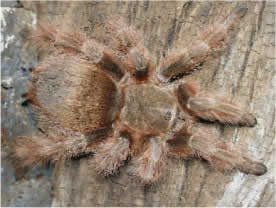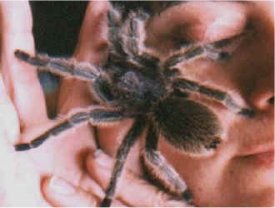The Chilean Rose Tarantula has been an important spider for more than thirty years!
The Rose-haired Tarantula Grammostola rosea is one of the most docile and hardy spiders being kept. It is a very durable tarantula, originating from one of the driest scrub habitats in the world, the northern Atacama Desert region. The Chilean Rose Tarantula has been a standard in the pet hobby and science classrooms all across the planet.
Chilean Rose-haired Tarantulas are moderately large, stocky beauties. They have a leg span reaching about 5 inches (12.5 cm) as adults. They are colored in a dark brown to black but then covered with a coat of reddish-orange to pink hairs over the entire body. Their various common names are derived from this subtle rose casting on the hair. Common names include Rose-haired Tarantula, Chilean Rose Tarantula, Chilean Rose-haired Tarantula, Chilean Fire Tarantula and Chilean Red-haired Tarantula.
These are fascinating spiders. Chilean Rose Tarantulas are quiet and easy to care for. They have a long lifespan with females living up to about 20 years. They require very little space and are usually active in the evening and at night. Rose-haired Tarantulas are good natured and handleable, though holding them does cause them stress so is best kept to a minimum. These traits along with being commonly available and inexpensive make them an ideal species for a beginner and the advanced hobbyist as well.
For more Information on keeping Tarantulas, see:
Keeping Arachnids and Other Arthropods as Pets
Scientific Name
Grammostola rosea
Syns: Grammostola cala, Phrixotrichus cala, Grammostola spatulata
Habitat: Distribution/Background
The Rose-haired Tarantula Grammostola rosea was described by Walckenaer in 1837. They originate from Chile in the northern Atacama Desert region, one of the driest deserts in the world. They were thought to be a burrowing species, but current observations indicate that they hunt at night and find a sheltered area above ground to web themselves into during the day. Other common names it is known by are Chilean Rose Tarantula, Chilean Rose-haired Tarantula, Chilean Fire Tarantula, and Chilean Red-haired Tarantula.
Status
The Grammostola rosea are not on the IUCN Red List for Endangered Species.
Description
The Chilean Rose-hair Tarantula is a moderately large tarantula. They reach adult size in about 3 to 4 years with about a 5″ (12.5 cm) leg span. This stocky beauty is dark brown to black but is covered with a coat of reddish-orange to pink hairs over its entire body. This subtle rose casting on the hair is where the name comes from.
Mature males have longer legs and are somewhat more fuzzy in appearance. The female remains stocky and bulky throughout its life. There are reports that mature males are more brightly colored than females but they can be quite variable in color. It is estimated that in captivity males may have a lifespan of up to 6 years and females up to about 20 years.
The Rose-haired Tarantula is one of the most difficult tarantulas to determine its “correct” scientific name. Not only has it gone through many name changes, it is still under discussion whether the different color forms are different varieties of this spider, or just color morphs. There are discussions about the Grammostola rosea and Grammostola cala being anatomically different and therefore two definite, different species, but this has not been confirmed. Most sources are currently reference this spider as Grammostola rosea.
 Grammostola gala – reddish phase Photo © Animal-World: Courtesy Russ Gurley
Grammostola gala – reddish phase Photo © Animal-World: Courtesy Russ Gurley Grammostola spatulata – brown phase Photo © Animal-World: Courtesy David Brough
Grammostola spatulata – brown phase Photo © Animal-World: Courtesy David BroughNaming them by their color morph appears as follows:
- Grammostola rosea – the standard
- Grammostola cala – a reddish phase
- Grammostola spatulata – brownish.
Food and Feeding
Rose-haired Tarantulas feed well on a variety of insect prey including crickets, grasshoppers, locusts, and others. They should be feed live insects once or twice a week.
Housing
The Rose-haired Tarantula thrives in a simple enclosure. Though not necessary, this Tarantula will like a scrubland type environment and will live in a shallow burrow if provided. A piece of driftwood, cork bark, or a hollow log will work well for this. Artificial or hardy live plants and other interesting decorations can also be added to the enclosure.
Temperature and humidity requirements:
This species will do best if you maintain the enclosure at 78° to 82° F. The humidity is best kept at between 60 to 80%. This can be accomplished by including and occasionally misting some sphagnum moss or orchid bark.
Cage Care
A good habit to get into is cleaning up any uneaten prey items the day after feeding your tarantula as decaying organic matter commonly attracts mites, fungus, mold and other potentially harmful organisms into the enclosure. If your pet has recently molted, remove uneaten prey items immediately. Newly molted tarantulas are vulnerable until their exoskeletons hardens.
Behavior
The Rose-haired Tarantula is usually active in the evening or night. They are not compatible with other spiders, even their own species, so they should be housed singly. They may be okay for a short period of time, but eventually one spider will kill the other.
Handling
This is one of the most docile species available in captive collections, easily handleable, and make wonderful pets. They may rear up when agitated and will even occasionally flick urticating hairs. After a short display, they will beat a hasty retreat or more commonly will simply walk away.
High-strung specimens will often show a dark bald patch on their abdomens from flicking away urticating hairs. Once they settle into captivity, this flicking rarely occurs and with a molt the bald patch is cleaned up and the coating of reds, oranges, browns, and pinks is restored.
You can carefully pick up these tarantulas by cupping them gently with the legs folded under their bodies. Another, gentler method is to simply place a hand out flat in front of them and gently prod the tarantula’s abdomen, forcing it to walk onto the hand. As they walk, simply place the other hand in front and have the spider walk across your hands.
Reproduction
Rose-haired Tarantulas have been bred in captivity for many years. Mature males have longer legs and are somewhat more fuzzy in appearance. The females seem to benefit from a cooling period of a couple of months prior to mating.
Once a mature male is produced, and he makes a sperm web, he should be introduced into the female’s enclosure. He will approach the female’s shelter cautiously, tapping and vibrating his legs. The female will be “lured” out of her burrow or shelter and the male will typically lunge forward to use his hooks to hold the female’s chelicerae and to push her into an almost upright position to give himself access to the female’s epigyne for mating. The male will insert either the left pedipalp, right pedipalp, or both alternately into the female’s epigyne and inject the fertilizing fluid into this area.
If fertilized, the female will produce an egg sac in the following weeks. This species produces large egg sacs, usually containing in excess of 500 babies. A mature male can be introduced to multiple females or can be reintroduced to a female to enhance the possibilities of a successful pairing. Typically, the male will die in the weeks following a successful mating.
Diseases: Ailments/Treatments
Tarantulas are generally quite hardy and adaptable if they are provided with the right environment. A few signs that may indicate that your pet is not acting or feeling normal are a loss of appetite, lethargy, looking overly skinny, or pacing the enclosure.
A tarantula on its back is probably not sick. Most tarantula species flip onto their backs during molting. Though this is a very stressful and delicate time for tarantulas, if the humidity and warmth levels are correct, they will molt their exoskeleton, roll over, harden up, and within a week or two be ready for their next meals.
- Molting
One of the most common reasons for your pet to demonstrate unusual behavior is due to a molting period. As they outgrow their existing skin all tarantulas regularly go through an extensive molt, shedding their entire skin as well as the linings of their mouth, respiratory organs, stomach and sexual organs.
The process starts well before the actual molt. For several weeks prior to shedding they will be growing a new skin under their old one. During this time it is not unusual for a tarantula to get quite lethargic and even stop eating. There may also be lots of web spinning activity as they prepare to molt.
When they begin to molt, they lay on their backs with their legs up in the air looking as if they are dead. Be sure not to disturb your tarantula when you see this. The shedding process goes quickly and smoothly as long the environment has adequate humidity.
Once they have shed, their new skin is pale and very soft. The amount of time it takes for your pet to fully recover and be back to eating well will vary from a day or so up to several weeks depending on its size. Smaller spiders recover much quicker than larger ones. - Other Problems
Other problems are usually the result of some type of environmental stress. There may be a drop in the temperature of the enclosure, there may be parasites, or the tarantula may just not be comfortable with the depth of its hiding place. These things can be easily adjusted or changed, or you can try moving your pet to a new enclosure.
Availability
Rose-haired Tarantulas are becoming more and more common as captive-hatched specimens.
For years the only specimens available were imported (and imported by the thousands). Now that Chile no longer exports animals, most Rose-hairs are captive-produced animals. Fortunately, females can produce 300 to 500 spiderlings per egg sac so only a few captive breedings can supply dozens of hobbyists with this wonderful pet spider.
References
- Animal-World Resources: Reptiles, Amphibians, and Land Invertebrates
- Russ Gurley, Tarantulas and Scorpions in Captivity, Living Art Pub, Serpent’s Tale NHBD , 2005
- Samuel D. Marshall, Tarantulas and Other Arachnids, Barron’s Educational Series; 2nd edition 2001
- Russ Gurley, Color Guide to Tarantulas of the World I, Living Art Publishing 1994
- Philippe de Vosjoli, Arachnomannia, General Care and Maintenance of Tarantulas & Scorpion, Advanced Vivarium Systems, 1991
- John G. Browning, Tarantulas. T.F.H Publications, 1989
